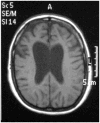Variants in triggering receptor expressed on myeloid cells 2 are associated with both behavioral variant frontotemporal lobar degeneration and Alzheimer's disease
- PMID: 23582655
- PMCID: PMC3830921
- DOI: 10.1016/j.neurobiolaging.2013.02.016
Variants in triggering receptor expressed on myeloid cells 2 are associated with both behavioral variant frontotemporal lobar degeneration and Alzheimer's disease
Abstract
Recent evidence suggests that rare genetic variants within the TREM2 gene are associated with increased risk of Alzheimer's disease. TREM2 mutations are the genetic basis for a condition characterized by polycystic lipomembranous osteodysplasia with sclerosing leukoencephalopathy (PLOSL) and an early-onset dementia syndrome. TREM2 is important in the phagocytosis of apoptotic neuronal cells by microglia in the brain. Loss of function might lead to an impaired clearance and to accumulation of necrotic debris and subsequent neurodegeneration. In this study, we investigated a consanguineous family segregating autosomal recessive behavioral variant FTLD from Antioquia, Colombia. Exome sequencing identified a nonsense mutation in TREM2 (p.Trp198X) segregating with disease. Next, using a cohort of clinically characterized and neuropathologically verified sporadic AD cases and controls, we report replication of the AD risk association at rs75932628 within TREM2 and demonstrate that TREM2 is significantly overexpressed in the brain tissue from AD cases. These data suggest that a mutational burden in TREM2 may serve as a risk factor for neurodegenerative disease in general, and that potentially this class of TREM2 variant carriers with dementia should be considered as having a molecularly distinct form of neurodegenerative disease.
Copyright © 2013 Elsevier Inc. All rights reserved.
Conflict of interest statement
The authors declare no actual or potential conflicts of interest.
Figures



References
-
- Beekly DL, Ramos EM, van Belle G, Deitrich W, Clark AD, Jacka ME, Kukull WA. The National Alzheimer’s Coordinating Center (NACC) Database: an Alzheimer disease database. Alzheimer Dis Assoc Disord. 2004;18:270–277. - PubMed
-
- Bianchin MM, Capella HM, Chaves DL, Steindel M, Grisard EC, Ganev GG, da Silva JP, Junior, Neto Evaldo S, Poffo MA, Walz R, Carlotti CG, Junior, Sakamoto AC. Nasu-Hakola disease (polycystic lipomembranous osteodysplasia with sclerosing leukoencephalopathy--PLOSL): a dementia associated with bone cystic lesions. From clinical to genetic and molecular aspects. Cell Mol Neurobiol. 2004;24:1–24. - PMC - PubMed
-
- Bouchon A, Dietrich J, Colonna M. Cutting edge: inflammatory responses can be triggered by TREM-1, a novel receptor expressed on neutrophils and monocytes. J Immunol. 2000;164:4991–4995. - PubMed
-
- Braak H, Braak E. Staging of Alzheimer’s disease-related neurofibrillary changes. Neurobiol Aging. 1995;16:271–278. discussion 278–284. - PubMed
Publication types
MeSH terms
Substances
Grants and funding
- UL1 TR000005/TR/NCATS NIH HHS/United States
- P50 AG005146/AG/NIA NIH HHS/United States
- P30 AG013846/AG/NIA NIH HHS/United States
- P30 AG010161/AG/NIA NIH HHS/United States
- MRC_/Medical Research Council/United Kingdom
- AG05144/AG/NIA NIH HHS/United States
- P50 AG005144/AG/NIA NIH HHS/United States
- AG10161/AG/NIA NIH HHS/United States
- P50AG05681/AG/NIA NIH HHS/United States
- R01 NS059873/NS/NINDS NIH HHS/United States
- P50 MH060451/MH/NIMH NIH HHS/United States
- P50-AG08671/AG/NIA NIH HHS/United States
- MH60451/MH/NIMH NIH HHS/United States
- TL1 TR000145/TR/NCATS NIH HHS/United States
- AG05146/AG/NIA NIH HHS/United States
- P50 AG16570/AG/NIA NIH HHS/United States
- P50 AG008671/AG/NIA NIH HHS/United States
- P50 AG05136/AG/NIA NIH HHS/United States
- P50 AG005128/AG/NIA NIH HHS/United States
- U24 AG021886/AG/NIA NIH HHS/United States
- R01 AG031581/AG/NIA NIH HHS/United States
- AG05128/AG/NIA NIH HHS/United States
- U01 AG016976/AG/NIA NIH HHS/United States
- P50 NS039764/NS/NINDS NIH HHS/United States
- P50 AG005681/AG/NIA NIH HHS/United States
- P50 AG005136/AG/NIA NIH HHS/United States
- NS39764/NS/NINDS NIH HHS/United States
- P50 AG016570/AG/NIA NIH HHS/United States
- P50 AG005134/AG/NIA NIH HHS/United States
- R01 AG034504/AG/NIA NIH HHS/United States
- R01 AG041232/AG/NIA NIH HHS/United States
- P30 AG19610/AG/NIA NIH HHS/United States
- AG034504/AG/NIA NIH HHS/United States
- P30 AG019610/AG/NIA NIH HHS/United States
- P30-AG13846/AG/NIA NIH HHS/United States
LinkOut - more resources
Full Text Sources
Other Literature Sources
Medical

